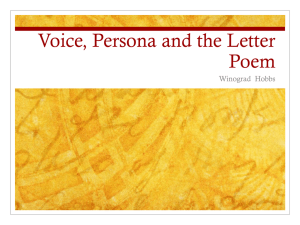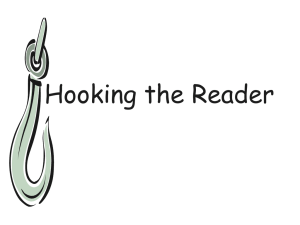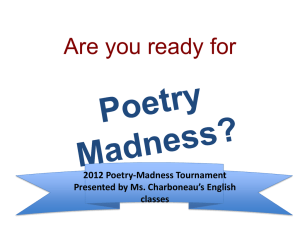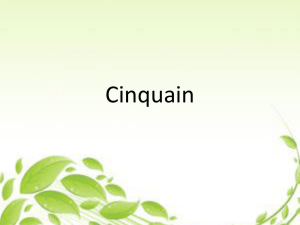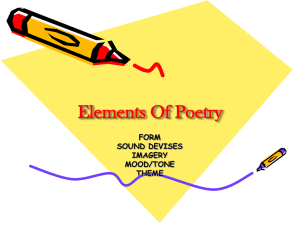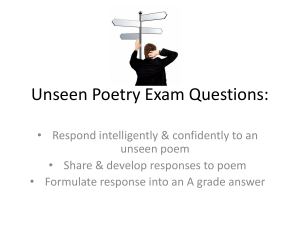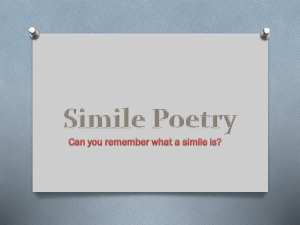The Almond Tree
advertisement
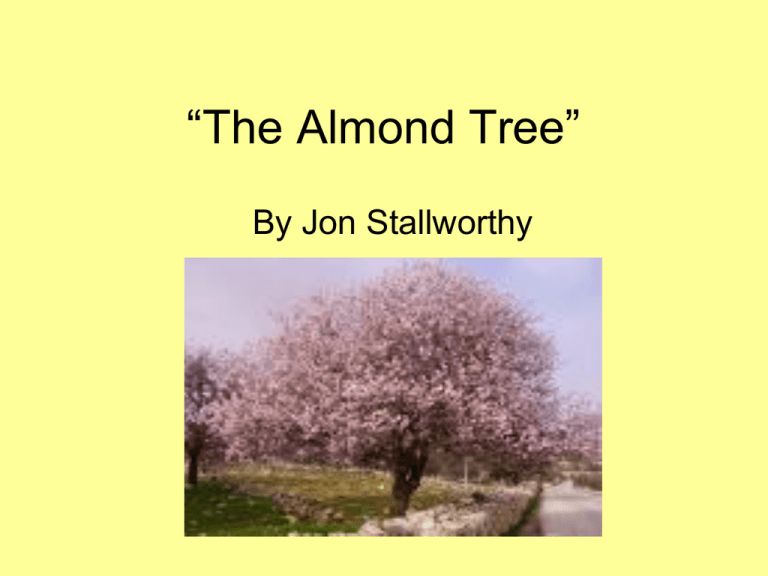
“The Almond Tree” By Jon Stallworthy “All the way to the hospital the lights were green as peppermints” • • • • • • Imagery – simile – excitement- children become excited by sweets – suggests that at this stage he has childish views on life. Childish in its cheerfulness and its innocence sets not only an intended mood but the basis for a dramatic contrast to come. ‘All’ – hyperbolic statement – optimism & naivety. Introduces the physical journey which takes place Introduces the first section of the poem – his journey to the hospital and his anticipation of the birth of his child. Do you think this is a natural response? “As if I were the lucky prince in an enchanted wood” • Sense of pride and good fortune • Fairytale imagery reinforces his childish perception of the world • Foreshadowing – woods are stereotypically associated with danger in fairytales • He is unaware of the reality that lies ahead “Swung by the road from bend to bend” • Personification – illustrates his lack of control – external forces are leading him to his destination. • This contrasts with his previous futile belief that he could control nature (summon summer…banish winter) • Foreshadowing – the reader is increasingly aware that his optimism and naivety may be thwarted • Introduces one of the main themes – fate. • The physical journey continues but is becoming increasingly challenging “blood was running down through the delta of my wrist and under arches of bright bone.” • • • • • • Introduces another key theme – the power of nature and its connection with all things. Personification mirrors the sense of urgency in his movements and illustrates his excitement Alliteration – mirrors the sound of his heartbeat Colour contrast – connotations of danger, or injury, with peace Reference to the physical form reminds us that this is not a fairytale Gruesome imagery reminds us of the man’s mortality and the frailty thereof. “Centuries, continents it had crossed; from an undisclosed beginning spiralling to an unmapped end.” •Journey – suggestion of time and distance travelled •“Spiralling” and “unmapped” – reinforces his lack of control over his own destiny. It is inherently dark and frightening. •“undisclosed” – reinforces the uncertainty of this situation and of life •“Centuries” and “continents” illustrate the enormity of the journey that he is embarking on •Introduces his literal and metaphorical journey •The tone at the end of this stanza is one of uncertainty and doubt. This marks the end of the first subdivision. Crossing (at sixty) Magdalen Bridge • Parenthesis – explicit reference to his sense of urgency • Reference to Magdalen Bridge (in Oxford) puts the poem into context • Oxford is renowned for the abundance of almond trees Let it be a son, a son, said the man in the driving mirror, Let it be a son. • Tone-– re-establishes the optimistic, cheerful tone. • Repetition – embodies his hope and eagerness for a son. In his naivety his only concern is the gender of his unborn child rather than for its health. • ‘the man’ indicates that as he reflects on the experience he no longer recognises his former self . The tower held up its hand: the college bells shook their blessings on his head. • Personification – in his optimism he interprets this gesture as a welcome • Bells – ambiguous – symbol of peace and good fortune. • “his head” – connotations of a christening. • A sense of foreboding is created as the clock chimes. ‘I parked in an almond's shadow blossom, for the tree was waving, waving at me upstairs with a child's hands.’ “shadow blossom – oxymoron – illustrates his optimism with the reality. “shadow” – dark and sinister connotations whist “blossom” has bright connotation development and nurture. There are two aspects to nature. The almond tree - symbolism • Stallworthy introduces the motif of the almond tree whose significance cannot be appreciated at this point. • This excerpt, like that of the peppermintgreen street lights, implies situational innocence. • This stanza concludes the first of the three major divisions of the poem – preceding the birth of the child. • Stallworthy uses these stanzas and their childish imagery to render a mood which the following lines will completely destroy. “Up the spinal stair” • “Up” – contrast in the optimistic tone created in the initial lines of the poem as it suggests that his journey will become more challenging • “Spinal” – further reference to the physical form and the associated frailty • Repeated references to the physical form create an ambiguous fear in the reader and a cold tone which seems to be leading to an event less endurable. • The metaphors of the body also indicate that the persona is once again going to face his mortality – his basic nature. “blood tide swung me swung me” • Reference to nature – the power of nature is illustrated in the fact that once again he does not have the ability to control it. • Repetition – mirrors the indiscriminate movement and emotions • Imagery – “blood tide” – connotations of a mass area of blood which further reinforces the gruesome nature of the delivery room. • Which is the most powerful element of nature? “whose walls shuddered with the shuddering womb” • Repetition of “shuddering” is ambiguous. It could refer to his wife’s contractions. This literal reference is continued with the reference to the “womb”. • The word choice is effective as it has sinister connotations and therefore could indicate his own response to the news of his child’s disorder. • The word evokes feelings of pain and distress; it is a word of helplessness, fear and withdrawal. Rhythm • Throughout the fifth stanza, to this point, the rhythm has been fast, irregular, with very short lines, sometimes containing only one word. • This suggests both the racing mind and the very quick heartbeat, both natural correlates of awaiting one’s child birth. • However, they are also frightening and seem to foreshadow something awful. “Newminted, my bright farthing! Coined by our love, stamped With our images, how you Enrich us!” • • • • • • • Tone – changes to one of elation. The imagery created by the extended metaphor implies that he feels that his life has been enhanced. The new coin just formed at the mint, suggests absolute perfection and purity. For the first time, a sense of unity has been suggested. The new father is ecstatic – he is finally secure, finally confident in the success of the birth. “best poem” – enriched expression of a man who truly believes that a father’s child is his greatest accomplishment. The language in this section is far more poetic and cathartic in its descriptiveness. Rhythm • The rhythm in these lines is much smoother and easier to read as if the man’s heart is finally at ease. “At seven-thirty the visitors' bell scissored the calm of the corridors.” • Tone – reverts to one of panic. • “Scissored” – negative connotations of an instrument of pain. • Symbolism – bells had previously been a sign of good fortune – this time the bells interrupt the scene of tranquility. • The precision of the time suggests that he is reliving this experience. “The doctor walked with me / to the slicing doors” • Word choice – reinforces an instrument of pain. • This enforces the suspense which has already been created. • The rhythm is still slow and evokes a sense of sympathy on behalf of the doctor. “His hand is upon my arm,/ his voice – I have to tell / you - set another bell / beating in my head” • Now the doctor, in his attempts to sustain the man’s composure, places an apologetic hand upon him and is obviously bracing him for some inconceivable information. • Notice the change from past tense to present tense – this recreates the situation for the reader further establishing our engagement with the persona and his experience. • Symbolism – bell – symbol of noise rather than music. • The chaos and panic of the man are paramount now, and Stallworthy has built his highest suspense. “your son is a mongol /the doctor said” • What is your response to this statement? • “mongol” – word choice evokes shock from the reader. • Consider the doctor’s actions prior to this. Do you think this is really what he would have said? Why do you think the persona heard these words? Dealing with the news • As the sixth group begins, the narrator begins the final phase of the poem – that of dealing with the news of his child’s handicap. • The stanzaic form for the poem’s remainder is consistently quatrains of a noticeable rhyme scheme and therefore rhythm has returned from what had been a scattered progression. • The rhythm gives the impression that this man, stunned at hearing the doctor’s words, is pacing, evenly and in rhythm, and attempting for the last subdivision of the poem to assimilate everything that has happened. “How easily the word went in - / clean as a bullet / leaving no mark on the skin,/ stopping the heart within it” • This simile evokes sympathy from the reader. • “leaving no mark on the skin” suggests that this is an internal pain. He is completely isolated in his injury which cannot be treated and cannot be appreciated by any other person. “stopping the heart within it” • The pain strikes the persona so suddenly and so intensely, that it stops his heart instantly and any superficial response is irrelevant. • The bullet symbolises instant death, and as the persona will express, this is precisely what he feels at this moment. “This was my first death” • He affirms that all for which he has lived to this point has been destroyed. • Death is a concept encompassing many elements, including the narrator’s likely feelings of loneliness, numbness, terror and hopelessness. • The idea of this being his “first” suggests two things: that this is the first time he will die, the last being the end of his life, and also that since he has never encountered such a devastating situation, this is the first time he has ever known pain and sadness to this extent. “studied the man below / as a pilot treading air” • So distraught is the persona that his spirit ascends from his body and he is able to look down upon his flesh. • He compares himself to a jet pilot who has ejected and is “treading air” – symbolic of the split-second’s ability to change power, vitality, and momentum into stagnation and vulnerability. • This pilot, like the narrator, feels no pain. • This may be from shock or from the physical abuse of the incident, but in either case, the metaphor is perfect. “snapped wires’ radiant ends.” • The extended metaphor climaxes in effectiveness and poetic excellence. • These wires, the reason for the pilot’s malfunction, could represent a number of things. • First, where technology is concerned, something such as wires’ failing in their purpose is so random and unpredictable, that no one can explain it. • It is chaotic, a matter of microscopic imprecision, and this fraction of an inch may mean loss, perhaps of human life. • This metaphor brilliantly includes the cruel selectiveness of fate, the unexplainable fraction of an inch which led to this infant’s life being intellectually limited for the duration of his life. • Secondly, the metaphor if wires relates to the child’s brain. So complex is the brain, that a person cannot possibly understand all of its functions and properties. This is well exemplified by a board of circuits, tangled and distinguishable to the extreme that, should one wire fail, to remedy the problem would be impossible, its effects on the system undeniable. “buckled shell of his plane – boot, glove and helmet feeling no pain” • The persona lists items that were supposed to protect him from harm but are rendered useless due to the severity of the situation. “Unfamiliar / the body of my late self / I carried to the car” • This phrase’s imagery presents the man slouching, barely capable of movement in his sadness. It is the image of a broken man, who must summon all his energy to continue with his now-empty life. • The final line of the sixth section also declares that the man’s body, already conceded to death, is unfamiliar to him. • The euphemism is effective in evoking sympathy from the reader. • He is frightened and confused, and from this point forward, he will be living as though within a dead, hollow shell. “The hospital – its heavy freight / lashed down ship-shape ward over ward” • The final sub-section of Stallworthy’s “The Almond Tree” finds the persona reaching his climactic assertion of how he is to handle what has happened. • It begins with the metaphor of a ship, the hospital, whose freight is the many patients within. • Reminds the reader of his literal and metaphorical journey. • “ship-shape” – connotations of the monotonous routines within the wards of the hospital. “steamed into night with some on board / soon to be lost if the desperate / charts were known” • The “desperate charts” to which the persona refers are those of the stars – fate – which no one wholly understands nor can they control. • The ship will lose some of its freight for no reason other than the cruelty of circumstance, the angry father affirms to himself. “Others would come / altered to land or find the land / altered.” This observation seems to suggest that those who survived may find more difficulty than those who did not. The persona is referring to his son and the terrible fate with which he has been cursed: his perspective of the world which he has been part of has been altered. The extended metaphor reminds us of his metaphorical journey from innocence and youth to one whose experience has provided him with the harsh reality of life. “In a numbered cot / my son sailed from me; never to come / ashore to my kingdom / speaking my language” • The extended metaphor is continued. • The father concedes his loss; loss of hopes and dreams of the relationship which he had envisaged for he and his son, the birth of whom, he so eagerly anticipated. • He and his son will never be united in the way he had intended. • Rather, this child’s course will run to another “kingdom”, another world, where the narrator does not understand. • The reference to his “kingdom” is reminiscent of the idealistic fairytale that was created in the opening stanza of the poem. Therefore, the contrast between hopes and the reality is highlighted which compels us to sympathise with his anguish. • This child will never speak the language of poetry and this may also be a source of deep pain. “Better not look that way.” • This marks the turning point in the poem. • He has had the highest hopes for his child, entertained the brightest predictions for his life, and now these hopes have been stifled. • He has now conceded the circumstances, and has decided to move forward with his life, rather than to dwell in his present misery. “The almond tree / was beautiful in labour. Blood-/dark, quickening, bud after bud / split, flower after flower shook free.” • The significance of the almond tree now becomes clear. • Stallworthy’s most skilful deployment of symbolism is evident through the imagery of the tree. Stallworthy’s writing is at its most complex in the following stanzas, as the speaker shifts frequently between himself and the almond tree. Through this symbolism he suggests a scene of childbirth. The reader appreciates the imagery of a mother giving birth, but by doing so, Stallworthy establishes a connection between the tree and the narrator. The tree, beautiful in labour, is something from which the man is learning the message of the poem. • Why do people often offer gifts of flowers? • Consider how a flower develops. Ironically, the bud of a flower – which is what we deem to be its most beautiful aspect – is a sign of its maturity which very quickly leads to its death. • Similarly, one can appreciate that the persona feels that, despite the fact that the splitting of each bud led to the death of his former self, this has actually enhanced his former self. “On the darkening wind a pale / face floated. Out of reach.” • This pale face is that of his son. On this ship, he is floating out to sea, out of reach of he who had loved him most. • The connotations of his son’s pale face that floated are that of ghostliness. “Only when / the buds, all the buds, were broken / would the tree be in full sail.” • Immediately, the focus shifts back to the tree. • The combination of ship and tree metaphors compound the complexity of the concept that losing is actually gaining. • The tree is becoming more beautiful, more fulfilled, as it shakes free its flowers. • Similarly, the persona, as he has lost something critical in his life, is becoming more complete, and in some way more beautiful, as well. • The more painful the experience of the man, the more he will grow in wisdom and strength. Losing his son is a terrible experience but the persona admirably chooses to use this experience to grow in these ways. Trivia • Perhaps Stallworthy is alluding to the Nietzschean view that what does not kill one, makes one stronger. • Kanye West did not conceive this philosophy. Fact! “In labour the tree was becoming / itself” • The tree is affirmed as a tree through its hardships and ultimately losing its flowers. • The man is also becoming more of a man through the pain of his son’s disability. “I too, rooted in earth / and ringed by darkness, from the death / of myself saw myself blossoming” • He as become a greater person because of his experience. His spiritual death has catalysed a spiritual rebirth. • “rooted” suggests that he is now feels a sense of permanence in this world – perhaps due to his responsibilities – rather than in a magical land in a fairytale. • “ringed by darkness” effectively illustrates the wisdom which he now beholds. As trees mature the rings within the trunk reflect their age and associated wisdom. “wrenched from the caul of my thirty/ years’ growing, fathered by my son,/ unkindly in a kind season/ by love shattered and set free.” • He has accepted his fate, and that of his son, and he feels free in an ironic way. • “fathered by my son” means that it his child who has given him wisdom – who has taught him. He has escaped from his life of conventional “growing” and has now truly grown as a person. • The irony in this final stanza implies the contrast between his enlightenment and the blindness with which he has travelled through life thus far. • The persona, broken and symbolically destroyed by his son’s condition, has been resurrected by faith in the natural cycle and an appreciation for spiritual growth. • Through all of his emotional changes the narrator has concluded his reflection with an enlightened perspective and moral. The Almond Tree? • Throughout the poem, the almond tree appears frequently, though not directly within the plot. • Early in the work, the man parks beneath its shadowy branches, and the tree is protecting him in this way. • Later, upon his ascension from his physical being, it is the tree which calls him back to earth, back to life. • Finally, as the poem concludes, the almond tree teaches the man what he needs to learn regarding his perspective of life and how to manage his emotions. Symbolism • While the tree plays no pure role throughout the poem it is a constant symbol on many levels. • First, a tree cannot act, cannot voice opinion or defend itself. Therefore, a tree is at the mercy of its environment or, from its fate. In this way, it symbolises the role of fate in the man’s life, and his helplessness in changing it. • The almond tree also symbolises nature and its processes. When it calls the man to earth, it is signalling that nature is beautiful, and even when its random tragedies occur, one must accept it as one aspect of an infinitely large and superior cycle. • Finally, the tree symbolises strength and perseverance, as it inspires the narrator to re-evaluate his situation and to make the decision to continue on, rather to surrender to his sadness. • The almond tree, though passive, delivers some of the most powerful messages throughout the poem. Summary • “The Almond Tree”, by Jon Stallworthy, is an outstanding composition. • His use of symbolism, irony, rhythm, and diction is excellent in expressing a range of emotions. Furthermore, he conveys strong messages through these techniques, all of which the reader absorbs into his or her own life, as these are messages which affect all people. • The tree’s presence throughout the work is exceptionally special as it represents so many ideas. • Overall, Stallworthy’s poem is outstanding , and it is successful in conveying every complex human emotion and understanding to its reader.

